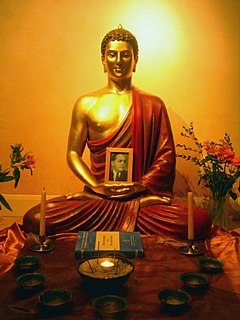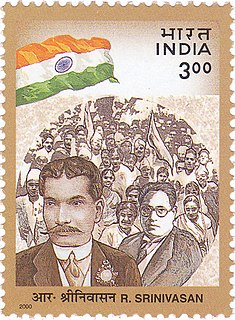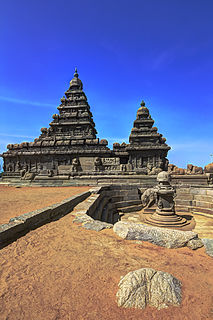Hindutva (transl. Hinduness) is the predominant form of Hindu nationalism in India. As a political ideology, the term Hindutva was articulated by Vinayak Damodar Savarkar in 1923. It is used by the organisation Rashtriya Swayamsevak Sangh (RSS), the Vishva Hindu Parishad (VHP), the Bharatiya Janata Party (BJP) and other organisations, collectively called the Sangh Parivar.

Bhimrao Ramji Ambedkar was an Indian jurist, economist, social reformer and political leader who headed the committee drafting the Constitution of India from the Constituent Assembly debates, served as Law and Justice minister in the first cabinet of Jawaharlal Nehru, and inspired the Dalit Buddhist movement after renouncing Hinduism.

The Bahujan Samaj Party (BSP) is a national level political party in India that was formed to represent Bahujans, referring to Scheduled Castes, Scheduled Tribes, and Other Backward Classes (OBC), along with religious minorities. According to Kanshi Ram, when he founded the party in 1984, the Bahujans comprised 85 percent of India's population, but were divided into 6,000 different castes. The party claims to be inspired by the philosophy of Gautama Buddha, B. R. Ambedkar, Mahatma Jyotiba Phule, Narayana Guru, Periyar E. V. Ramasamy and Chhatrapati Shahuji Maharaj. Kanshi Ram named his protégée, Mayawati, as his successor in 2001. The BSP has its main base in the Indian state of Uttar Pradesh where it was the second-largest party in the 2019 Indian general election with 19.3% of votes and third-largest in the 2022 Uttar Pradesh Legislative Assembly election with 12.88% of votes. Its election symbol is an elephant which is the same symbol historically used by Dr. Ambedkar's Scheduled Castes Federation.

The Neo Buddhist movement is a religious as well as a socio-political movement among Dalits in India which was started by B. R. Ambedkar. It radically re-interpreted Buddhism and created a new school of Buddhism called Navayana. The movement has sought to be a socially and politically engaged form of Buddhism.

Untouchability is a form of social institution that legitimises and enforces practices that are discriminatory, humiliating, exclusionary and exploitative against people belonging to certain social groups. Although comparable forms of discrimination are found all over the world, untouchability involving the caste system is largely unique to South Asia.
Dalit, also known as untouchable, is a name for people belonging to the lowest stratum castes in India. Dalits were excluded from the four-fold varna system of Hinduism and were seen as forming a fifth varna, also known by the name of Panchama. Dalits now profess various religious beliefs, including Hinduism, Buddhism, Sikhism, Christianity, Islam and various other belief systems. Scheduled Castes is the official term for Dalits as per the Constitution of India.

Mahar, meaning "original inhabitants of Maharashtra", is an Indian caste found largely in the state of Maharashtra and neighbouring areas. Most of the Mahar community followed B. R. Ambedkar in converting to Buddhism in the middle of the 20th century. As of 2017 the Mahar caste was designated as a Scheduled Caste in 16 Indian states.
Sanskritisation is a term in sociology which refers to the process by which castes or tribes placed lower in the caste hierarchy seek 'upward' mobility by emulating the rituals and practices of the dominant castes or upper castes. It is a process similar to "passing" in sociological terms. This term was made popular by Indian sociologist M. N. Srinivas in the 1950s.
Chuhra, also known as Bhanghi and Balmiki, is a Dalit caste in India and Pakistan. Populated regions include the Punjab region of India and Pakistan, as well as Uttar Pradesh in India, among other parts of the Indian subcontinent such as southern India. Their traditional occupation is sweeping, a "polluting" occupation that caused them to be considered untouchables in the Hindu caste system.
Bahujan is a Pali term frequently found in Buddhist texts, with a literal meaning of "the many", or "the majority". In a modern context, it refers to the combined population of the Scheduled Castes, Scheduled Tribes, Other Backward Classes, Muslims, and minorities, who together constitute the demographic majority of India. The word bahujan appears in the dictum "Bahujana sukhaya bahujana hitaya cha", articulated by Gautama Buddha.

Gail Omvedt was an American-born Indian sociologist and human rights activist. She was a prolific writer and published numerous books on the anti-caste movement, Dalit politics, and women's struggles in India. Omvedt was involved in Dalit and anti-caste movements, environmental, farmers' and women's movements, especially with rural women.

Navayana means "new vehicle" and refers to the re-interpretation of Buddhism by Bhimrao Ramji Ambedkar; it is also called Neo-Buddhism and Ambedkarite Buddhism. Ambedkar was a polymath, theologian and scholar of Buddhism. He was born in a Dalit (untouchable) family during the colonial era of India, studied abroad, became a Dalit leader, and announced in 1935 his intent to convert from Hinduism to a different religion, and he has studied all the major religions of the world in depth, including Hinduism, Islam, Christianity, Sikhism, and Buddhism, for nearly 21 years. Thereafter Ambedkar studied texts of Buddhism, found several of its core beliefs and doctrines such as Four Noble Truths and "non-self" as flawed and pessimistic, then re-interpreted these into what he called "new vehicle" Buddhism, or Navayana. Ambedkar held a press conference on 13 October 1956, announcing his rejection of Theravada and Mahayana Buddhism, as well as of Hinduism. Thereafter, he left Hinduism and adopted Navayana, about six weeks before his death. Its adherents see Navayana Buddhism not as a sect with radically different ideas, but rather as new movement founded on the principles of Buddhism.
Persecution and discrimination against Dalits has been observed in the countries such as Bangladesh, India, Pakistan, Nepal, the UK, and the US.

Diwan Bahadur Rettamalai Srinivasan, commonly known as R. Srinivasan, was a Scheduled Caste activist and politician from then Madras Presidency of British India. He is a Paraiyar icon and was a close associate of Mahatma Gandhi and was also an associate of B. R. Ambedkar. He is remembered today as one of the pioneers of the Scheduled caste movement in India. He founded the Adi dravida mahajana sabha in 1893.
The All India Backward and Minority Communities Employees Federation, abbreviated as BAMCEF, is an organisation for employees of oppressed communities that was established in 1971 by Kanshi Ram, D. K. Khaparde, and Dinabhana. The term got its significance from the Constitution of India, which intersects the oppressed and exploited Indians into classes on the basis of their status: Scheduled Castes (SC), Scheduled Tribes (ST), Other Backward Class (OBC) and Minority Communities. Waman Meshram is the organisation's current president.

Christophe Jaffrelot is a French political scientist and Indologist specialising in South Asia, particularly India and Pakistan. He is a professor of South Asian politics and history the Centre d'études et de recherches internationales (CERI) at Sciences Po (Paris), a professor of Indian Politics and Sociology at the King's India Institute (London), and a Research Director at the Centre national de la recherche scientifique (CNRS).
Ghar Wapsi is the programme of religious conversion to Hinduism and Sikhism from Islam, Christianity and other religions, conducted by Indian Hindu nationalist organisations Vishva Hindu Parishad (VHP), Rashtriya Swayamsevak Sangh (RSS) and their allies. The term owes to the Hindu nationalist ideology that all people of India are ancestrally Hindu and, hence, conversion to Hinduism is one of "returning home" to their ancestral roots.

Marathi Buddhists are Buddhists of Marathi ethnic and linguistic identity. The religious community resides in the Indian state of Maharashtra. They speak Marathi as their mother-tongue. The Marathi Buddhist community is the largest Buddhist community in India. According to the 2011 Indian census, Marathi Buddhists constitute 5.81% of the population in Maharashtra, which is 77% of the total Buddhist population in India.
The Ekatmata Yatras were a series of pilgrimages and political strategies used to promote Hindu Polity or Hindutva. The strategy involved the mobilization of large pilgrimages (Yatras) to gather support for pro-Hindu political positions. The concept of the Ekatmata Yatra was formulated by the Vishva Hindu Parishad in the early 1980s.

Hinduism is the largest religion in South Asia with about 1.16 billion Hindus, forming just under two-thirds of South Asia's population. South Asia has the largest population of Hindus in the world, with about 99% of all Hindus being from South Asia. Hinduism is the dominant religion in India and Nepal and is the second-largest religion in Bangladesh, Pakistan, Sri Lanka, and Bhutan.










